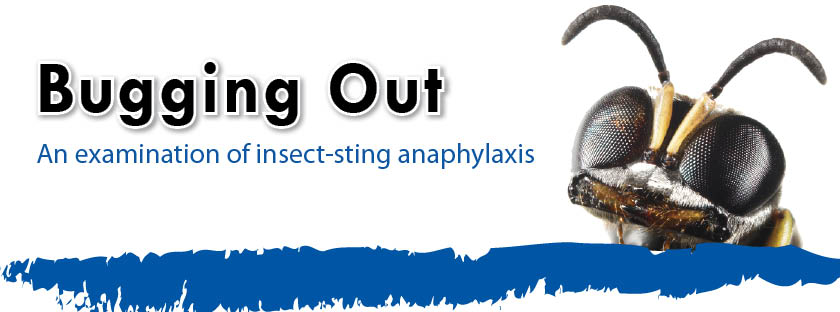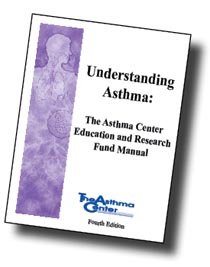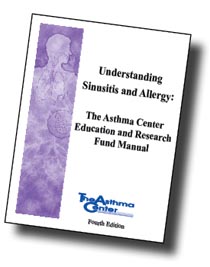Insect Sting Allergy
Printable PDF
Quick links:
Which insects cause allergy? | Types of allergic reactions to stinging insects | What to do when you're stung | Avoidance techniques | Insect venom immunotherapy

While stinging insects may have different homes and habits, they can all induce anaphylaxis in susceptible individuals. Fact: it has been reported that about 40 people die each year due to insect-sting allergy. Read on to find out how the right tests and treatment can save a life.
Insect bites—such as a mosquito or fly bite—can cause local swelling at the site due to the inflammatory effects of the insect’s saliva. However, stinging insects actually inject a small amount of venom into the skin, leading to significant local reactions and in some cases, allergic reactions—including anaphylaxis. Stinging insects that commonly cause allergic reactions fall into two groups:
Apids – these include honeybees, bumble bees and sweat bees.
Vespids –these include yellow jackets, hornets and wasps.
Honeybees are common in the northeast, not particularly aggressive, and are prominently involved in honey production and plant pollination. Disturbing the hive often results in multiple stings, which could lead to venom toxicity or a major anaphylactic reaction. Africanized honeybees are found in the southern U.S. and are very aggressive, but fortunately, they’re not in the Delaware Valley at this time.
Yellow jackets are the most common stinging insects in our area. They primarily come out in the late summer and fall. Since these insects nest in the ground, gardening or mowing the grass can elicit a full-scale attack. They’re often uninvited guests at outdoor picnics and may swarm around people wearing bright colors or perfumes. And of course, they’ll often convene at one of their favorite hangouts—an overflowing trash can.
Hornets—the yellow jackets’ close relation—nest in hedges, and are often compelled to defend their home when a hedge needs trimming. Wasps are fewer in number in our area, but they’re not aggressive and prefer to build their nests under the eaves of buildings.
Common local reaction
Erythema and swelling at the site of the sting is common, lasting a few hours.
Large local reactions
Marked swelling and redness at the site of the sting that continues to enlarge over hours or days can occur in 10% of stings. Swelling and discomfort can last more than a week and can involve an entire extremity.
Treatment for local reactions
Patients receive antihistamines to relieve itching, aspirin or NSAIDs for inflammation and pain, and oral corticosteroids for more severe reactions. Prednisone at a dose of up to 40 mg per day is usually effective in one to two days, but it may need to be taken for up to a week in severe local reactions. Antibiotics are usually necessary.
Anaphylactic or systemic reactions
Generalized allergic reactions can be severe—even life threatening—but only 0.5-3% of the population suffer an anaphylactic reaction due to an insect sting. Systemic reactions are most common in children, but adults suffer the most serious outcomes and are at the highest risk.
Most people who have an anaphylactic reaction to insect stings have no history of respiratory allergy. The worst reactions usually begin within a few minutes following the sting. Systemic symptoms commonly include skin reactions (hives, flushing, itching, or angioedema).
The most serious reactions cause difficulty in breathing (shortness of breath, wheezing, obstruction of the upper airway due to angioedema) and cardiovascular symptoms (drop in blood pressure, fainting, vertigo). Less common symptoms involve the GI tract (abdominal cramps, diarrhea and occasionally severe uterine cramps).
Uncommon reactions
Serum sickness like disease—symptoms of swelling at the site of the sting followed some days later with symptoms of arthralgia, arthritis, general malaise, rash, lymphadenopathy, and/or fever is an uncommon immunological response to the insect sting. A bout of serum sickness following a sting increases the chance of future anaphylactic reactions after the next sting. Rarely reported allergic responses to insect stings include: nephritis, vasculitis, encephalitis and other acute neurological problems.
Mortality and insect-sting anaphylaxis
Although death can occur due to insect-sting anaphylaxis at any age, it most commonly occurs in adults. Perhaps adults are more susceptible to severe hypotension and cardiovascular shock because of underlying cardiovascular disease. Many of these individuals have had no prior history of severe insect sting allergy. Furthermore, adults on beta-blockers carry a particular risk. The only way to objectively identify the presence of insect-sting hypersensitivity is through allergy testing. Assuming a person is currently allergic to insect stings because of a prior history of anaphylaxis can lead to a false assumption.
Some patients lose their hypersensitivity over time following documented insect sting anaphylaxis. Both allergy skin testing and the in vitro RAST assay are used to identify those with elevated specific IgE antibodies directed at insect venom. Allergy skin testing appears to be more sensitive than the RAST assay and has the advantage of using the same material for testing and treatment. Insect venom for testing is limited to the following insects: honey bee, yellow jacket, white face hornet, yellow hornet, and wasp.
About 15-20% of people tested to insect venom have positive reactions to allergy skin testing, while their RAST assays for the same allergen are negative.
Insect-sting anaphylaxis recurs in 60% of patients who reported anaphylaxis from a prior sting. Therefore, it stands to reason that 40% of individuals apparently have lost their prior hypersensitivity! A positive skin tests, or RAST, to insect venom can indicate who might be at risk for recurrence of anaphylaxis, but this is not completely accurate. In contrast, a negative allergy skin test and RAST for venom usually indicates that future venom anaphylaxis is unlikely.
If a systemic anaphylactic reaction occurs, an injection of epinephrine is available with an Epipen™ or Twinjet™. These adrenaline-filled auto injectors are self-administered at either a child’s dose of 0.15 mg or an adult dose of 0.3mg. Adrenalin should be administered at the first sign of an anaphylactic reaction and the patient should be transported to the emergency room immediately. If available, both an antihistamine (Benadryl) and a corticosteroid may offer some benefit after the adrenalin has been administered.
In the emergency room or a well-equipped physician’s office, the patient may require I.V. fluids in large amounts, additional adrenalin, I.V. corticosteroids, oxygen, and less commonly, intubation or laryngoscopy. When it comes to insect-sting anaphylaxis, prevention is the best medicine. With insect venom immunotherapy, this life-threatening reaction is preventable in 95-100% of affected individuals.
Specific insect venom immunotherapy
Allergy injections treatment (immunotherapy) containing stinging insects’ venom allergens became available in 1980. These treatments for honeybee, yellow jacket, hornet and wasp stings have effectively prevented recurrence of anaphylaxis in previously sensitive individuals. At this time, any individual with a history of systemic anaphylaxis and a positive skin test must be offered treatment with venom immunotherapy. We recommend this therapy to adults and children with a history of systemic anaphylaxis, as well as adults with cutaneous anaphylaxis (hives) and angioedema. Venom immunotherapy consists of weekly injections of small doses of the purified venom collected from insects causing the anaphylactic reaction.
The doses increase with each injection and the patient will usually reach his or her maintenance dose (maximum dose) over a period of three to four months. Maintenance therapy is administered every four to six weeks and treatment usually lasts about five years or can be discontinued when the insect venom skin test converts to a negative test. However, there is a 10% risk of systemic reaction with each sting after discontinuation. Patients that have had severe hypotension or upper airway angioedema should continue on venom immunotherapy indefinitely or until the venom skin test is negative, indicating that the patient has truly lost his/her hypersensitivity to the venom sting.
Side effects from venom immunotherapy
Even small amounts of subcutaneous insect venom can lead to a large local reaction, swollen arms, hives, or anaphylaxis including wheezing, hypotension, and or angioedema. Slow, and careful buildup of insect venom injections is effective in most cases. But when severe reactions occur, patients may require adrenalin, tourniquets, I.V. fluids, oxygen, as well as intubation equipment. Our office is also equipped with an EKG and oximeter, which will be helpful in managing severe reactions. Medical-legal implications of insect-sting allergies To treat, or not to treat? Death due to anaphylaxis following an insect sting is preventable. Therefore, serious medical-legal implications can accompany an inadequately treated patient who may be at risk.
Simply prescribing an Epipen or similar device without testing for venom hypersensitivity or referral to an allergist could potentially be ruled as malpractice in court. In cases of a severe reaction, these treatments may not be effective. Considering the 95-100% prevention rate of anaphylaxis using venom immunotherapy, withholding information about this accessible treatment is not only below the community standards of medical practice, but it is jeopardizing our medical responsibility as healers.



